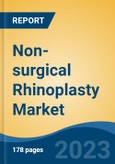Speak directly to the analyst to clarify any post sales queries you may have.
10% Free customizationThis report comes with 10% free customization, enabling you to add data that meets your specific business needs.
This minimally invasive technique involves the use of injectable dermal fillers to reshape and enhance nasal contours without the need for surgery. The procedure is typically completed in under an hour and allows patients to resume daily activities almost immediately, offering an appealing solution for individuals with active lifestyles. Compared to surgical rhinoplasty, it offers significantly reduced recovery time, minimal risk, and instant, noticeable results - factors contributing to its growing popularity.
Market Drivers
Rising Demand for Minimally Invasive Aesthetic Procedures
The healthcare sector has been shifting toward less invasive treatment options, with consumers increasingly seeking alternatives to conventional surgery. This trend is supported by benefits such as shorter recovery periods, reduced procedural risks, and lower costs. According to the American Society of Plastic Surgeons (ASPS), minimally invasive cosmetic procedures in the U.S. increased by 7% in 2023, surpassing the growth rate of surgical treatments.Non-surgical rhinoplasty has become a prominent trend within the broader aesthetic medicine space. Its appeal lies in the absence of incisions and sutures, resulting in lower levels of discomfort and downtime. The procedure offers a high degree of customization, allowing practitioners to tailor treatments to individual facial structures and patient preferences. As consumer interest grows, the market is expected to continue its upward trajectory, supported by ongoing advancements in technology and product development.
Market Challenges
Safety Concerns and Regulatory Variability
Despite its non-invasive nature, non-surgical rhinoplasty presents certain safety challenges that could hinder market expansion. The use of dermal fillers - primarily hyaluronic acid - carries risks such as vascular occlusion, which can lead to complications including tissue necrosis or vision impairment. The nasal area’s complex vascular structure heightens the potential for adverse outcomes, especially when procedures are performed by inadequately trained or unlicensed individuals.Additionally, inconsistent regulatory standards across regions contribute to variable treatment quality and outcomes. In some countries, oversight regarding qualified practitioners and approved materials is limited. The proliferation of counterfeit or substandard fillers further elevates the risk, leading to patient hesitation. Negative media coverage of botched procedures amplifies public concerns. Enhancing patient and provider education, standardizing training protocols, and implementing stricter regulations will be essential to build consumer confidence and ensure procedural safety.
Market Trends
Technological Advancements Driving Market Innovation
Technological innovation is playing a pivotal role in the evolution of the non-surgical rhinoplasty market. Recent developments in dermal filler formulations - particularly those using hyaluronic acid - have led to safer, more durable, and more effective products. These advancements have significantly improved patient satisfaction and procedural outcomes.Cutting-edge tools such as 3D imaging and simulation software are transforming the consultation process, enabling both practitioners and patients to visualize expected results in advance. This not only enhances precision but also builds greater trust and transparency between provider and client.
Further, the emergence of needle-free injection systems is reducing discomfort and bruising, making the procedure even more accessible to needle-averse individuals. Long-lasting fillers that maintain their effects for up to two years are also gaining traction, offering a more cost-effective and convenient solution for patients.
As technology continues to advance, the non-surgical rhinoplasty market is expected to benefit from greater procedural efficiency, improved patient outcomes, and expanded treatment capabilities, positioning it for sustained growth.
Key Market Players
- Thermo Fisher Scientific, Inc.
- SKINovative of Gilbert - Medical Spa
- The London Cosmetic Clinic
- Laser Clinic United Kingdom
- Therapie Clinic
- Toronto Cosmetic Clinic (TCC)
- Canada MedLaser, Inc.
- Skin Vitality Medical Clinic
- True MediSpa Skin & Laser Clinic
- Nova Aesthetic Clinic
- VIVA Skin Clinic
- Piedmont Plastic Surgery & Dermatology
Report Scope:
In this report, the Global Non-surgical Rhinoplasty Market has been segmented into the following categories, in addition to the industry trends which have also been detailed below:Non-surgical Rhinoplasty Supplements Market, By Filler Type:
- Hyaluronic Acid Filler
- CaHa Filler
Non-surgical Rhinoplasty Supplements Market, By Application:
- Convex Nose
- Indentations of dorsal hump
- Minor Nasal Asymmetry
- Others
Non-surgical Rhinoplasty Supplements Market, By End-use:
- MedSpa
- Hospital/Surgery Center
- HCP-owned Clinic
Non-surgical Rhinoplasty Supplements Market, By Region:
- North America
- United States
- Canada
- Mexico
- Europe
- France
- United Kingdom
- Italy
- Germany
- Spain
- Asia-Pacific
- China
- India
- Japan
- Australia
- South Korea
- South America
- Brazil
- Argentina
- Colombia
- Middle East & Africa
- South Africa
- Saudi Arabia
- UAE
Competitive Landscape
Company Profiles: Detailed analysis of the major companies present in the Global Non-surgical Rhinoplasty.Available Customizations:
With the given market data, the publisher offers customizations according to a company's specific needs. The following customization options are available for the report.Company Information
- Detailed analysis and profiling of additional market players (up to five).
This product will be delivered within 1-3 business days.
Table of Contents
Companies Mentioned
- Thermo Fisher Scientific, Inc.
- SKINovative of Gilbert - Medical Spa
- The London Cosmetic Clinic
- Laser Clinic United Kingdom
- Therapie Clinic
- Toronto Cosmetic Clinic (TCC)
- Canada MedLaser, Inc.
- Skin Vitality Medical Clinic
- True MediSpa Skin & Laser Clinic
- Nova Aesthetic Clinic
- VIVA Skin Clinic
- Piedmont Plastic Surgery & Dermatology
Table Information
| Report Attribute | Details |
|---|---|
| No. of Pages | 182 |
| Published | April 2025 |
| Forecast Period | 2024 - 2030 |
| Estimated Market Value ( USD | $ 0.75 Billion |
| Forecasted Market Value ( USD | $ 1.19 Billion |
| Compound Annual Growth Rate | 8.0% |
| Regions Covered | Global |
| No. of Companies Mentioned | 12 |









